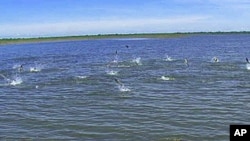Asian Carp now outnumber native fish in many areas of the United States and their expansion particularly threatens the fragile ecosystems of the Great Lakes.
In an effort to control algae growth, catfish farmers in the southern United States introduced Asian Carp - a species of fish found in China - into their ponds in the 1970s. Flooding throughout the last several decades washed the fish out of those ponds into other waterways. Gradually, the species multiplied and spread north along major rivers such as the Mississippi and the Illinois.
Anywhere else in the world, this would be a fisherman's dream, rivers so abundant with fish they jump out of the water, and often right into the boat. But these are not the kind of fish that get anglers in the United States excited. They are known as Asian Carp and the explosion of their population in the Illinois River is a concern to large-river ecologist Kevin Irons.
"They compete with every other fish that's in our water," said Irons. Irons is part of a team with the Illinois Natural History Survey, which is spearheading an effort to kill or contain Asian Carp before they reach Lake Michigan. The group routinely patrols the Illinois River near Havana - searching for Asian Carp, which are not hard to find. To understand where and how much the invasive species is spreading, Irons and his crew use a method known as electro fishing to stun the Asian Carp so they can be captured and counted.
"There's as many as 4,100 adult silver carp per mile here on the middle Illinois River," said Irons. "So they very quickly turn into about 13 tons per mile, and when you look at an eighty mile [129 kilometer] reach, it's phenomenal how much bio mass is taken up by these Asian Carp."
There are two types of Asian Carp in the Illinois River - bighead and silver. Both eat the same food as other - native - fish, such as catfish and buffalo. Asian Carp can weigh up to 45 kilograms each, and eat up to half their body weight in food per day.
Gradually, Asian Carp edge out the other native species in the river until they are one of the only kinds of fish left. It is catastrophic to the natural ecosystem, and a problem for the fishing industry in the U.S., which looks at Asian Carp as an undesirable fish to eat.
"Americans in general don't like a bony fish," said Irons. "The rest of the world eats silver carp, they're actually the most cultured fish in the world. And they're overfished almost everywhere because they are so desired for human consumption."
With no natural predator in the water, and almost no domestic market to sell them as food, Asian Carp threaten to expand into waterways through the city of Chicago, and into Lake Michigan, about 320 kilometers northwest of Havana.
"This is where we decided to draw the battle lines," said John Rogner, the assistant director of the Illinois Department of Natural Resources. "We have an electrical barrier in place that we are confident will keep them from moving en masse into the Great Lakes. And then our job is to put out the brush fires so to speak. The fish that, for one reason or another, that found their way past the barrier, we suppressed them and try to take them out of the system to keep them from establishing in Lake Michigan."
In June, a bighead Asian Carp was found above the electrical barrier about ten kilometers from Lake Michigan. The discovery raised the level of concern that the invasive species was closer to Lake Michigan than previously thought. But the Illinois Department of Natural Resources is confident their containment measures are working, as they have yet to find more Asian carp above the electric barrier.







